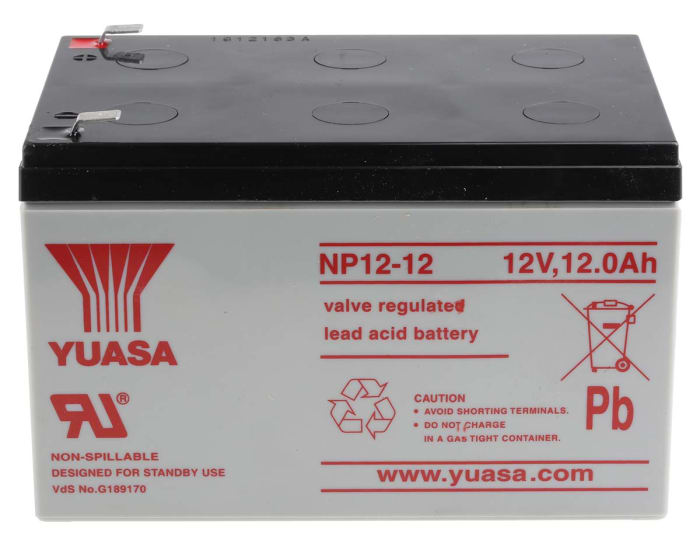Technical Document
Specifications
Brand
RS ProCapacity
12Ah
Nominal Voltage
12V
Construction
AGM
Terminal Type
T1
Flame Resistant
No
Dimensions
151 x 98 x 95mm
Maximum Operating Temperature
+ 50°C
Minimum Operating Temperature
- 20°C
Designed for Cyclic Application
No
Application
Stand by Use
Designed High Rate Application
No
Eurobat Classification
3 to 5 Years
Chemistry
Lead Acid
Operating Temperature Range
-20 → +50°C
Brand Range
RS PRO
Weight
3.5kg
Country of Origin
China
Product details
Lead Acid Rechargeable, RS Pro
RS Pro Lead acid batteries are suitable for use across a number of industries as well as for general purpose.
They are sealed and have many uses, and are ideal for their uninterruptable power supply and emergency back-up.
These batteries are long life rechargeable batteries.
Features and Benefits
5 years standby design
Float Standby use
Low gas emissions 99% plus recombination
Excellent recovery from deep discharge
Leak proof – Sealed batteries
ABS resin case to UL94-HB fire resistance (Horizontal Burning Test)
Road transport to UN2800 (Batteries, Wet, Non-Spillable)
Air Transport to Special Provision ’A67’ ’IATA’ & ’ICAO’. (Batteries, Wet, Non-Spillable)
Typical Applications
Automotive Industry
Aviation Industry
Golf Carts
Emergency Lighting
Medical Equipment
Wheel Chairs
Forklifts
FAQ's
GEL Vs AGM Lead Acid Batteries
AGM (Absorbed Glass Mat)
These batteries contain only enough liquid to keep the specially designed glass mat wet. The glass mat is made to wick the battery electrolytes between the battery plates. If the AGM battery is broken no free liquid leaks out.
AGM batteries are preferred when a large amount of amps are required. The life expectancy remains excellent in most cases, if they are not discharged more than 60% between recharges and/or recharged fully every 3-6 months.
Gel Cell Batteries
These batteries contains silica type gel, which is a thick paste like material. It allows the electrons to flow between plates, but will not leak in a gel battery if the case is broken.
Gel Cell Batteries don't offer the same power capacity as do the same physical size as AGM batteries. Gel cell batteries excel in slow discharge rates and slightly higher operating temperatures and with excellent deep cycle capability. Recharging these batteries must be done correctly or it will suffer a premature failure.
Are Lead Acid Rechargeable Batteries Harmful?
Lead acid batteries contain chemicals that have the potential to be harmful to both your health and the environment. They contain lead which is a highly toxic metal and sulfuric acid which is a corrosive electrolyte solution.
Proper handling procedures must be followed at all times.
How to dispose of Lead Acid Batteries?
These batteries do contain hazardous chemicals so recycling is the only way to dispose of them.
Recycle responsibly. A wide range of schemes are available.
Warning
Do not charge in a sealed enclosure
€ 54.52
€ 54.52 Each (ex VAT)
1
€ 54.52
€ 54.52 Each (ex VAT)
Stock information temporarily unavailable.
1
Stock information temporarily unavailable.
Technical Document
Specifications
Brand
RS ProCapacity
12Ah
Nominal Voltage
12V
Construction
AGM
Terminal Type
T1
Flame Resistant
No
Dimensions
151 x 98 x 95mm
Maximum Operating Temperature
+ 50°C
Minimum Operating Temperature
- 20°C
Designed for Cyclic Application
No
Application
Stand by Use
Designed High Rate Application
No
Eurobat Classification
3 to 5 Years
Chemistry
Lead Acid
Operating Temperature Range
-20 → +50°C
Brand Range
RS PRO
Weight
3.5kg
Country of Origin
China
Product details
Lead Acid Rechargeable, RS Pro
RS Pro Lead acid batteries are suitable for use across a number of industries as well as for general purpose.
They are sealed and have many uses, and are ideal for their uninterruptable power supply and emergency back-up.
These batteries are long life rechargeable batteries.
Features and Benefits
5 years standby design
Float Standby use
Low gas emissions 99% plus recombination
Excellent recovery from deep discharge
Leak proof – Sealed batteries
ABS resin case to UL94-HB fire resistance (Horizontal Burning Test)
Road transport to UN2800 (Batteries, Wet, Non-Spillable)
Air Transport to Special Provision ’A67’ ’IATA’ & ’ICAO’. (Batteries, Wet, Non-Spillable)
Typical Applications
Automotive Industry
Aviation Industry
Golf Carts
Emergency Lighting
Medical Equipment
Wheel Chairs
Forklifts
FAQ's
GEL Vs AGM Lead Acid Batteries
AGM (Absorbed Glass Mat)
These batteries contain only enough liquid to keep the specially designed glass mat wet. The glass mat is made to wick the battery electrolytes between the battery plates. If the AGM battery is broken no free liquid leaks out.
AGM batteries are preferred when a large amount of amps are required. The life expectancy remains excellent in most cases, if they are not discharged more than 60% between recharges and/or recharged fully every 3-6 months.
Gel Cell Batteries
These batteries contains silica type gel, which is a thick paste like material. It allows the electrons to flow between plates, but will not leak in a gel battery if the case is broken.
Gel Cell Batteries don't offer the same power capacity as do the same physical size as AGM batteries. Gel cell batteries excel in slow discharge rates and slightly higher operating temperatures and with excellent deep cycle capability. Recharging these batteries must be done correctly or it will suffer a premature failure.
Are Lead Acid Rechargeable Batteries Harmful?
Lead acid batteries contain chemicals that have the potential to be harmful to both your health and the environment. They contain lead which is a highly toxic metal and sulfuric acid which is a corrosive electrolyte solution.
Proper handling procedures must be followed at all times.
How to dispose of Lead Acid Batteries?
These batteries do contain hazardous chemicals so recycling is the only way to dispose of them.
Recycle responsibly. A wide range of schemes are available.
Warning
Do not charge in a sealed enclosure


